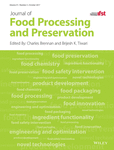Improved rheological properties of chicken egg frozen gels fortified by ᴅ-ketohexoses
Funding information: City Area Program, the Ministry of Education, Culture, Sports, Science & Technology, Japan; PhD thesis
Abstract
The aim of this study was to examine the rheological properties of chicken egg gels containing 10% ᴅ-ketohexose (ᴅ-fructose, ᴅ-allulose, ᴅ-tagatose, and ᴅ-sorbose) and to compare the effects of ketohexoses on freeze-thawing of egg gels with ᴅ-glucose (Glc), sucrose (Suc), and trehalose (Tre). In both whole egg (WE) and egg white (EW) gels, ketohexose-gels had higher breaking stress than Glc-, Suc-, and Tre-gel (WE gels, 15.6–35.3%; EW gels, 7.6–26.1%). The ketohexose-gels of WE showed similar viscoelastic properties and water-holding capacity to Glc-, Suc-, and Tre-gel. Ketohexose-gels of EW possessed higher viscosity and higher water-holding capacity than the other sugar-gels. Ketohexoses more effectively suppressed the syneresis and physical properties of egg gels by freeze-thawing than Glc, Suc, and Tre did. The application of ketohexoses to egg gel products can improve the quality of frozen foods that contain egg gels.
Practical applications
Sugar is extensively used for producing egg-based gel products because sugar contributes to the stabilization of food structure and adds sweetness. Sugar also prevents deterioration of the physical properties of frozen foods from freezing and thawing. Interest in the rare ketohexoses ᴅ-allulose (Alu) and ᴅ-tagatose (Tag) is growing in food industry, because Alu and Tag have some health benefits, such as prevention of postprandial blood glucose level and suppression of adiposity. The utilization of rare ketohexoses as food ingredients should improve the rheological and functional properties of food products, including those of frozen foods.




